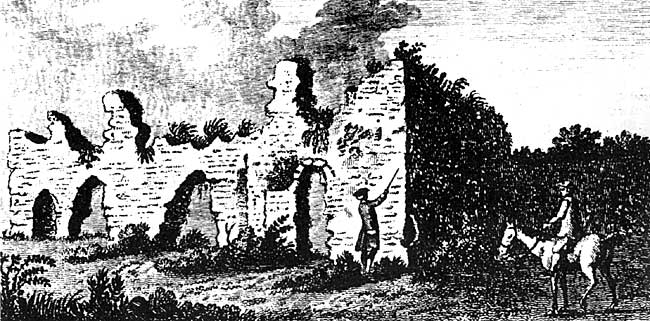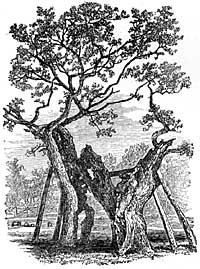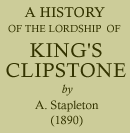Chapter IX.
House of Brunswick. 1714, down to date.
The historical story of Clipstone may be said to have ended, practically, with the Caroline War. Subsequent ages have been so uneventful as to leave scarcely anything to record beyond the slight notes and comments of local writers, such as will here be mentioned under the dates of their publications. Upwards of a century from the time of Thoroton is therefore compulsorily passed over.

"The King's House, Clipstone" in 1784.
1783.—The ruins of the Kings' House, unfortunately, have rarely been made the subject of the engraver's art. The earliest, probably, and perhaps also the best pictorial representation is in Grosse's Antiquities, published this year. It was drawn for the author by the local antiquary Major Rooke. It also appears in Throsby's work, in the next decade,—besides a smaller sketch in a vignette under the author's portrait. There is a small woodcut of the ruin, it may be added, in a book on Worksop, &c., printed in 1875.
1799.—Major Rooke published his pamphlet on Sherwood Forest this year. In his list of nine keepers occurs Len. Huntington for Birkland, Bilhagh, and Clipstone Skroggs. Skrogs or scrogs is said to signify stunted woody growth, and this no doubt illustrates the character of that part of the forest-land so designated at Clipstone. The keepers above mentioned were appointed by the Verderers during pleasure, having each an annual salary of twenty shillings, paid by the Duke of Newcastle out of fee-ferm rent for Nottingham Castle. Near the north end of Clipstone Park, adds Rooke, is a large tree called the Broad Oak, which measures 27 feet 6 inches in circumference.
1810.—An incident occurred about this year which, to the antiquarian student, was almost of similar disastrous import to the demolition of the House in the sixteenth century. The Duke of Portland had the old foundations dug up entirely, with the object of utilising the stone in his new system of drainage. Probably numerous objects of interest would be turned up on the ancient site, of which no record has been preserved, though in all likelihood the 'large vaults,' which it has been so often stated existed previously, are merely a more recent imaginative development of the word 'foundations.' Still the only means by which, in modern times, might have been ascertained the original extent, character, plan, and style of the buildings, the period of their erection, and other points of deepest interest, have been removed for ever, and no chart or notes preserved.
1813.—Laird in his topographical work published this year, says Clipstone Park contains a handsome lodge, but small and modern, belonging to that nobleman (Duke of Portland). This park, he continues, is near eight miles in circumferance. The only part remaining of the palace, which stands in a large field close to the village, seems to have been the hall; and several of its Gothic windows are yet entire. Its foundations have, formerly, been very extensive, but during the last summer great part of these were dug up to be employed in a system of drainage which the Duke of Portland has commenced upon his property here. We understood, however, from the workmen, that his Grace had given strict orders that the venerable walls of this once royal pile should not be touched. Even in its present delapidated state it would be picturesque if shaded with planting; it is still, notwithstanding, interesting, and strongly raises the idea of times long past, when steel-clad knights and barons bold, and haughty priests, and smiling courtiers, and straight-laced dames, and blushing damsels and the whole etcetera of feudal pomp and high-minded chivalry paced its now deserted halls, where the bat and toad assume the empire of the night, and where the sun only breaks in upon a scene of desolation.
1827.—The following poetical allusion to the palace and to King John occurs in Robert Millhouse's Sherwood Forest and other poems, 1827 :—
But lo! where yonder claim the minstrels' song,
The mouldring ruins of a kingly dome !
Here, oft retiring with his hunter throng,
The timid despot sought this greenwood home,
When foiled by England's Peers,
or vexed by haughty Rome.
The ruins do not appear to have often attracted the attention of the poetically-inspired, which is probably due, in some degree, to their insignificance. Miss Williams, in her poem on Sherwood Forest, 1832, alludes to them.
1832.—In White's first Nottinghamshire Directory occurs:—On our visit we observed under the ruins large heaps of stones which some churlish surveyor appeared to have broken for the purpose of repairing the roads, and which would have been so appropriated had not his Grace, on hearing of the delapidation, forbidden their removal. Of the 1648 acres in this township, nearly 900 form one of the wildest wastes of the forest. Clipstone feast is on the first Sunday in November.
The area given is that of the Park,—not the township. Two public-houses (the same number as at present) are mentioned in this directory, viz.: Fox and Hounds and the Dog and Duck. The former name remains, but the latter, apparently, has changed to the present Portland Arms.
1839-40.—In the first volume of the Journal of the Royal Agricultural Society is a paper on Clipstone Water Meadows (with plan), from which the following notes are taken:—
The land immediately occupied by these meadows was in its wild state a line of hill-sides, covered with gorse and heather,—a rabbit-warren over which a few sheep wandered,—and a swampy valley below, thick set with hassocks and rushes, the favourite haunt of wild ducks and snipes, through which the Maun wound its way. The whole track, both upland and lowland, was of very little value. The valley was in many places from nine to ten feet deep in bog, and almost worthless; the hill-sides varied in quality; but £80 a year would have been a full rent for the 300 acres. Indeed, the whole of the Clipstone Park farm, when taken in hand in the year 1816, containing 1487 acres, had been let for the sum of £346.
1841.—The drawing-room at the Park Farm was fitted up as a place of worship, the Duke of Portland paying the Vicar of Edwinstowe £50 per annum for doing duty there once every Sunday.
In the Census for this year the inhabitants are set down as 286; acres in the township, 4,017. Unfortunately I have not been able to consult the census for any of the four previous and earliest occasions (1801, 1811, 1821, 1831).
1842.—The erection of the "Duke's Archway," the design of which is said to have been taken from the Priory Gatehouse, Worksop, was commenced in June.
1844.—White's Directory:—Nine cottage houses, one acre of freehold, and four acres of copyhold land belong to other proprietors (than the Duke of Portland). There is every reason to suppose that Clipstone will soon emerge—under the fostering care of his Grace—from being the most decayed village in the county, and become the neatest.
This year the tithes were commuted,—the great tithe for £380, for which the Duke of Portland is lessee under Earl Manvers, and £168 for the vicarial tithe.—Directory, 1853.
Curtis, in his work published about this year, gives the following flourish concerning the Flood Dykes, and other notes:—A perennial fertility is maintained, and luxuriant crops of grass and clover flourish over a district where comparative sterility once reigned in absolute and apparently interminable power. The Lodge, a farm house, is built on the site of some former mansion, part of the remains of which are incorporated with the present edifice. Parliament Oak remains, and another has been planted to succeed and mark the spot (?) Part of the lordship is uninclosed. Clipstone has one-third of the charitable bequest left by Ann and William Monday in 1627, i.e., the whole estate of the above, consisting of 109 acres and 3 perches of land, the rents thereof to be distributed for the benefit of the poor of the parish by the churchwardens of Edwinstowe. 1851.—265 inhabitants.
1861.—266
1871.—220
1881.—256
1883.—This year was published, by the Historical Manuscripts Commission, a report on the Thoresby archives. The report, however,—in glaring contrast to the admirable ones of the present day,—is so meagre and ill done as to be all but worthless. The only local notes are:— Thick folio, vellum, 16th century, surveys of Clipstone, Cuckney, and other places. Pleas of Sherwood Forest at Nottingham before the Justices of the King itinerant on the morrow of St. Hillarie, 15 Ed. (one is)—The plee betwixt the Abbot of Rufford and the Men of Edwinstowe and Clipstone for pulling up trees and gaderinge of wood in the said Abbot and Covent woodes, &c.
The latter item appears to refer to the claim denied to the Men of those manors in the Abbot of Rufford's Patent, 1414-15.
1886.—White's Directory.—The Lodge (or Archway, built of Mansfield Woodhouse limestone) was completed in 1844, at a cost of £16,000 (?)— a large and elegant stone building, consisting of a noble carriage archway in the centre, with a dwelling on each side, and over the archway a school-room. The school is free to all poor girls in Clipstone from five to fifteen years of age, and boys from five to seven. The girls are all clothed at the expense of the Duke of Portland; average attendance 30. Under the powers of a scheme issued in 1880, all the land of the Monday Charity has been sold, the total produce being £5,507, which is invested in the 3 per cents.; the annual income is £160, of which £40 is given for educational purposes, and the remainder is distributed among the poor, Clipstone receiving two-ninths.
In concluding this work, it must be admitted that such valuable matter has been omitted as could probably have been supplied by a native or one thoroughly acquainted with the village,— the present writer having only seen it twice. Yet perhaps I have rendered the work lighter to anyone who may hereafter undertake it in a more complete manner, for it is easier to build on the roughest foundations than to undertake and plan a work from the commencement. Moreover, under the present arrangement, it will be a simple matter to find what has been omitted.

Parliament Oak.
Parliament Oak may yet be said to exist, and when I saw it, on Bank Holiday, 1887, there was an inscription on an iron plate, on a post in front of it, bearing the name of the Oak, and a request that visitors would assist in protecting the tree from wilful damage. Such scant fragments of its battered shell remain, however, that it is all but a thing of the past. Guide-books state that a healthy strip of wood and bark, which on one side carries vitality to a living branch, is gradually forming an independent tree which will perpetuate the growth when the remains of the old shell have fallen away. It is worthy of remark that, on the above date, there was a similar growth on the opposite side, so that with good fortune we may calculate on having a double Parliament Oak in years to come, when the original has entirely vanished. This will still, of course, be parts of the original tree, and may last as long. The external diameter of the shell was then about eleven feet, and the internal diameter, between the living saplings, five feet.
Though the glory of Royal Clipstone is in the past, some consolation may be derived from the circumstance that, since the accession to the estates of the present Duke of Portland, the visits of the nobility have in a way been revived.
The future historian who takes the pains to search local newspaper or society paper files will be able to record many such, particularly in September of each year—for the Doncaster Races week. On Saturday, 25th September, 1886, the Duke and Duchess of Teck, Princess Victoria, Lord and Lady Cremorne, Lord and Lady Galway and others, guests of Mr. Saville at Rufford Abbey, drove over to Hardwick Hall, returning by way of Mansfield and Clipstone. In September 1887 the Duke of Portland headed a large shooting party at Clipstone, comprising, doubtless, numerous distinguished persons. I have a dim recollection, if I am not mistaken, of reading of the Prince of Wales shooting over His Grace's preserves here. During September of the present year the Duke entertained a party at Welbeck, which included the Dukes of Beaufort and Hamilton, Earl and Countess Cadogan, the Marquis of Londonderry, Earl and Countess of Enniskillen, Lord and Lady Algernon Gordon-Lennox, Lord and Lady Hastings, Lord Calthorpe, Lord Randolph Churchill, and Colonel Forester. On one day of the race week a party of the guests shot over the Duke's estates of Langwith and Clipstone. Modern peers, however, do not come to visit the spot so rich in associations of past nobility—even if they are aware of its existence.
Anyone, however, standing in the corn field beneath the piece of old wall, and on the site of the Royal Manor House, with the ploughed earth and hedges around, will find it difficult to realise that on this spot such an apparently everlasting pile once stood. Where the noble Plantagenets lodged and hunted,—the neighbouring woods echoing with the shouts of the chase, Where the mighty men of th whole kingdom thronged to the Parliament (exactly six centuries ago), with trains of courtiers and retainers. Where priests chanted, princes and peers lived luxuriously, and forest outlaws, perhaps, peered forth and watched with impotent hate. Still the fragment remains to convince us, though the statement that this rude wall is probably a part of the hall of the building is a mere guess which there is nothing to support. Also, the dictum of certain local guide-books, to the effect that some stones of the old Chapel of St. Edwin remain, is also evidently without foundation.
In spite of the statement that much demolition of the above-ground portion of the ruins took place when the foundations were removed, yet, on comparison of the old views with what still exists, no very great difference is evident. However, the mortar between them being not quite "as hard as the stones themselves" the rough mass is doubtless gradually crumbling and lessening,—suggestive of those lines from Shakespere which are said to have first inspired Robert Millhouse, "the Burns of Sherwood Forest:"—
The cloud-capt towers, the gorgeous palaces,
The solemn temples, yea the great globe itself,
And all which it inherit, shall dissolve,
And, like the baseless fabric of a vision,
Leave not a rack behind !
